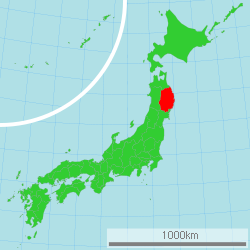
Search Jobs

 Carved out of the former Mutsu province and later Morioka domain, Iwate prefecture is a mostly rural area located in northern Honshu. Bordered by the Ou mountains in the west and a rugged coastline on the east with a scattering of fishing villages, most of its 1.3 million residents reside in several cities along an east side valley that runs north and south with bullet train service through the capital city of Morioka, which is a mid-sized regional city with a population of nearly 300,000 people. The climate is humid continental with hot, humid summers, cold winters and moderate amounts of snowfall depending on the area.
Carved out of the former Mutsu province and later Morioka domain, Iwate prefecture is a mostly rural area located in northern Honshu. Bordered by the Ou mountains in the west and a rugged coastline on the east with a scattering of fishing villages, most of its 1.3 million residents reside in several cities along an east side valley that runs north and south with bullet train service through the capital city of Morioka, which is a mid-sized regional city with a population of nearly 300,000 people. The climate is humid continental with hot, humid summers, cold winters and moderate amounts of snowfall depending on the area.
The name “Iwate” or “rock hand” is said to have originated from the tale of Oni no tegata, which is connected with the Mitsuishi or “Three Rocks” Shrine in Morioka. The story goes that after these three rocks were deposited in Morika from an eruption of Mt. Iwate, a devil had been harassing the local people who then prayed to the spirits of the three rocks for protection. The devil was then shackled to the these rocks and forced to promise never to bother these people again. He imprinted his hand on one of the rocks as a seal of his pledge. Locals claim that this hand print is still visible after a rain.
For a prefecture with the lowest population density outside of Hokaido, Iwate has as many as 40 English conversations schools (excluding branches) that hire native English speakers and about half as many other types of educational institutions that may employ foreign teachers. Most of these are located in Morioka City, which has some sizable manufacturing activity, namely in semiconductors and communications equipment. The eastern coastal areas have extensive fishing operations, which include the dubious claim to producing more than half of Japan’s annual 1,400 tons of whale and dolphin meat. Then, the interior valley area has some beef and even more chicken production. Historically, there had been much mining activity in Iwate but very little in the present day while foresty activities continue.
Things to do and see in Iwate include Morioka Castle (built in 1611), Iwate Safari Park, Morioka Zoological Park, Iwate Kogen Snow Park Koiwai Farm, Miyazawa Kenji Dowa Mura (Fairytale Village), Morioka Handcrafts Village, Jodogahama (rock formations with cave, seaside resort, and beaches), Ryusendo (large limestone cave, lake and science museum), Geibikei (gorgeand river, nationally designated Place of Scenic Beauty), Mount Iwate (stratovolcano complex in the Ou Mountains, 2,038 meters), Goishi Coast (nationally designated Place of Scenic Beauty), Fujisan Ryokan onsen (riverside lodging with open-air baths), Osawa Onsen, Tsunagi Onsen, Sukawa Kougen Onsen, Aishinkan Onsen, Chuson-ji Temple, Motsuji Temple, Takkoku-no-Iwaya Temple, Kanjizaio-in Temple, Mitsuishi Shrine, Morioka Hachimangu Shrine, Sakurayama Shrine, etc.
Major museums include the Iwate Museum of Art, Morioka Hashimoto Museum of Art, Miyazawa Kenji Museum, Tono City Museum, and the Takuboku Ishikawa Memorial Museum.
The Morioka Sansa Odori Festival from August 1 to 4, is one of the Five Great Festivals of Tohoku. Over 10,000 taiko drummers and dancers (a world record for drummers) parade in costume and perform the Sansa dance, which is said to have originated when locals rejoiced and danced when the wicked demon placed his hand print on the famous rock promising no more bad deeds. The Iwate Snow Festival is one of the Five Great Snow Festivals of Tohoku. Held at Koiwai Farm in early February, there are many large and small snow sculptures, sledding, sleighing, riding a snow train, etc. Other festivals include the Morioka Fall Festival, the Chagu Chagu Umakko Festival, the Hanamaki Festival on the 2nd Saturday of Semptember, the Kitakami Michinoku Geino Festival , the Hidaka Hibuse Festival on April 29, the Ugoku Tanabata Festival / Kesencho Kenka Tanabata Festival on August 7, and the Morioka Fireworks Festival (largest fireworks display in Morioka)
Morioka is famous for its noodle cuisine with a variety of local specialties. Jaja Noodles are thick udon noodles topped with cucumber, green onion, ginger, a meat-miso sauce and more. Morioka reimen (cold Korean ramen) is a cold spicy beef broth with kimuchi and some fruit similar to a North Korean dish called naengmyeon, but in Iwate the noodles are made from potato starch. Wanko soba noodles are said to be the original soba noodles and served in small portions with refills until the diner puts a lid on the plate to indicate he or she is finished. Iwate-machi fried udon is fried in olive oil and special peppery sauce with cabbage, seasonal vegetables, and topped with local meat and sesame seeds. Seafood is abundant in Iwate coastal regions with oyster huts serving products from nearby oyster aquaculture farms. Other local foods include a myriad of rice cake (mochi) foods in the south, hittsumi (a hot pot of flour dumplings in a shoyu-based stew of chicken, burdock root, carrots, mushrooms, etc.), Kitakami croquettes (with taro, asparagus, and beef or pork inside), and several grain-based porridges unique to local towns.

